Stimulated Thermal Scattering in Two-Photon Absorbing Nanocolloids under Laser Radiation of Nanosecond-to-Picosecond Pulse Widths
Abstract
:1. Introduction
2. Materials and Methods
2.1. Preparation of Stable Ag and ZnO Nanoparticle Suspensions
2.2. Measurements of the Two-Photon Absorption Coefficient of Laser Radiation in Nanoparticle Colloids
2.3. Nanosecond 2PA SRMS Experimental Scheme
2.4. Picosecond 2PA SRMS Experimental Scheme
3. Results
3.1. Experimental Results of 2PA SRMS in the Nanosecond Time Domain
3.2. Experimental Results of 2PA SRMS with 100 ps Laser Pulse Width
4. Discussion
4.1. Model of the Nonlinear Medium Response under 2PA SRMS
4.2. Theory of 2PA SRMS through Four-Wave Mixing in Nanosecond Regime
4.3. Theory of Picosecond 2PA SRMS Backward Signal Amplification
5. Conclusions
Author Contributions
Funding
Informed Consent Statement
Data Availability Statement
Conflicts of Interest
References
- He, G.S.; Tan, L.-S.; Zheng, Q.; Prasad, P. Multiphoton Absorbing Materials: Molecular Designs, Characterizations, and Applications. Chem. Rev. 2008, 108, 1245–1330. [Google Scholar] [CrossRef] [PubMed]
- Chevychelova, T.A.; Zvyagin, A.I.; Perepelitsa, A.S.; Ovchinnikov, O.V.; Smirnov, M.S.; Selyukov, A.S. Role of photoinduced destruction of gold nanorods in the formation of nonlinear optical response. Optik 2022, 250, 168352. [Google Scholar] [CrossRef]
- Zvyagin, A.I.; Chevychelova, T.A.; Grevtseva, I.G.; Smirnov, M.S.; Selyukov, A.S.; Ovchinnikov, O.V.; Ganeev, R.A. Nonlinear refraction in colloidal silver sulfide quantum dots. J. Russ. Laser Res. 2020, 41, 670–680. [Google Scholar] [CrossRef]
- He, G.S.; Law, W.-C.; Liu, L.; Zhang, X.; Prasad, P. Stimulated Mie scattering in nanocrystals suspension. Appl. Phys. Lett. 2013, 101, 011110. [Google Scholar] [CrossRef]
- He, G.S.; Law, W.-C.; Baev, A.; Liu, S.; Swihart, M.T.; Prasad, P. Nonlinear optical absorption and stimulated Mie scattering in metallic nanoparticle suspensions. J. Chem. Phys. 2013, 138, 024202. [Google Scholar] [CrossRef] [PubMed]
- Zel’dovich, B.Y.; Popovichev, V.I.; Ragul’skiy, V.V.; Faizullov, F.S. Connection between the wave fronts of the reflected and exciting light in stimulated Mandel’shtam–Brillouin scattering. Sov. Phys. JETP 1972, 15, 109. [Google Scholar]
- Zel’Dovich, B.Y.; Pilipetsky, N.F.; Shkunov, V.V. Principles of Phase Conjugation; Springer Series in Optical Sciences 42; Springer: Berlin, Germany, 1985; pp. 85–107. [Google Scholar]
- Boyd, R.W. Nonlinear Optics, 3rd ed.; Academic Press: New York, NY, USA, 2007; pp. 429–470. [Google Scholar]
- Brignon, A.; Huignard, J.P. Phase Conjujate Laser Optics; John Wiley Pub. Co.: Hoboken, NJ, USA, 2004. [Google Scholar]
- He, G.S. Optical phase conjugation: Principles, techniques, and applications. Prog. Quantum Electron. 2002, 26, 131–191. [Google Scholar] [CrossRef]
- He, G.S. Stimulated Scattering Effects of Intense Coherent Light. Prog. Opt. 2009, 53, 201–292. [Google Scholar] [CrossRef]
- He, G.S.; Zhen, C.L.; Prasad, P.N.; Zerom, P.; Boyd, R.W.; Samoc, M. Stimulated Rayleigh-Bragg scattering in two-photon absorbing media. Phys. Rev. A 2005, 71, 063810. [Google Scholar] [CrossRef] [Green Version]
- Erokhin, A.I.; Smetanin, I.V.; Mikhailov, S.I.; Bulychev, N.A. Spectral shifts of stimulated Rayleigh-Mie scattering in Ag nanoparticle colloids. Opt. Lett. 2018, 43, 1570–1573. [Google Scholar] [CrossRef]
- Smetanin, I.V.; Erokhin, A.I.; Baranov, A.N. Frequency up-shift in the stimulated thermal scattering under two-photon absorption in liquids and colloids of metal nanoparticles. Laser Phys. 2018, 28, 075402. [Google Scholar] [CrossRef] [Green Version]
- Bulychev, N.A.; Kazaryan, M.A.; Gridneva, E.S.; Murav’ev, E.N.; Solinov, V.F.; Koshelev, K.K.; Kosheleva, O.K.; Sachkov, V.I.; Chen, S.G. Plasma discharge with bulk glow in the liquid phase exposed to ultrasound. Bull. Lebedev Phys. Inst. 2012, 39, 214–220. [Google Scholar] [CrossRef]
- Ivanov, A.I.; Nikiforov, V.N.; Shevchenko, S.V.; Nimoshenko, V.Y.; Pryadin, V.V.; Bulychev, N.A.; Bychenko, A.B.; Kazaryan, M.A. Properties of metal oxide nanoparticles prepared by plasma discharge in water with ultrasonic cavitation. Int. J. Nanotechnol. 2017, 14, 618–626. [Google Scholar] [CrossRef]
- Bulychev, N.A.; Kazaryan, M.A.; Chaikov, L.L.; Burkhanov, I.S.; Krasovskii, V.I. Nanoscale metal oxide particles produced in the plasma discharge in the liquid phase upon exposure to ultrasonic cavitation. 1. Method for producing particles. Bull. Lebedev Phys. Inst. 2014, 41, 264–268. [Google Scholar] [CrossRef]
- Klassen, N.; Krivko, O.; Kedrov, V.; Shmurak, S.; Kiselev, A.; Shmyt’ko, I.; Kudrenko, E.; Shekhtman, A.; Bazhenov, A.; Fursova, T.; et al. Laser and Electric Arс Synthesis of Nanocrystalline Scintillators. IEEE Trans. Nucl. Sci. 2010, 57, 1377–1381. [Google Scholar] [CrossRef]
- Ozgur, U.; Alivov, Y.I.; Liu, C.; Teke, A.; Reshchikov, M.A.; Dogan, S.; Avrutin, V.; Cho, S.-J.; Morkoc, H. A comprehensive review of ZnO materials and devices. J. Appl. Phys. 2005, 98, 041301. [Google Scholar] [CrossRef] [Green Version]
- Krasovskii, V.I.; Feofanov, I.N.; Rasmagin, S.I.; Zadorin, D.A.; Zakharyan, R.A.; Kazaryan, M.A.; Chaikov, L.L.; Bulychev, N.A.; Averyushkin, A.S.; Garibyan, B.A. Non-linear optical properties of nanosized metal oxide particles obtained in plasma discharge in liquid phase under ultrasonic cavitation. Proc. SPIE 2018, 10614, 173–178. [Google Scholar] [CrossRef]
- Feofanov, I.N.; Bulychev, N.A.; Kazaryan, M.A.; Chaikov, L.L.; Burkhanov, I.S.; Averyushkin, A.S.; Krasovskii, V.I.; Rasmagin, S.I.; Zadorin, D.A.; Chen, C.H. Nanoscale metal oxide particles produced in the plasma discharge in the liquid phase upon exposure to ultrasonic cavitation. 3. Optical nonlinearities of particle suspensions. Bull. Lebedev Phys. Inst. 2016, 43, 174–178. [Google Scholar] [CrossRef]
- Gordeev, A.A.; Efimkov, V.F.; Zubarev, I.G.; Mikhailov, S.I. Phasing of Stokes radiation under shock excitation of stimulated Brillouin scattering. Quantum Electron. 2011, 41, 997–1002. [Google Scholar] [CrossRef]
- Herman, R.M.; Gray, M.A. Theoretical prediction of the stimulated thermal Rayleigh scattering in liquids. Phys. Rev. Lett. 1967, 19, 824–828. [Google Scholar] [CrossRef]
- Kaiser, W.; Maiers, M. Stimulated Rayleigh, Brillouin and Raman spectroscopy. In Laser Handbook; Arecchi, F.T., Schulz-Dubois, E.O., Eds.; North-Holland: Amsterdam, The Netherlands, 1972; p. 1077. [Google Scholar]
- Bojarska, A.; Marona, L.; Czernecki, R.; Khachapuridze, A.; Suski, T.; Perlin, P.; Smetanin, I.V. Cavity-free lasing and 2D plasma oscillations in optically excited InGaN heterostructures. J. Russ. Laser Res. 2014, 35, 447–456. [Google Scholar] [CrossRef]
- Eichler, H.J.; Günter, P.; Pohl, D.W. Laser-Induced Dynamic Gratings; Springer: Berlin, Germany, 1986. [Google Scholar]
- Vladimirov, V.S. Equations of Mathematical Physics; Mir Publisher: Moscow, Russia, 1984. [Google Scholar]
- Abramowitz, M.; Stegan, I. Handbook of Mathematical Functions with Formulas, Graphs, and Mathematical Tables; U.S. Government Printing Office: Washington, DC, USA, 1970. [Google Scholar]


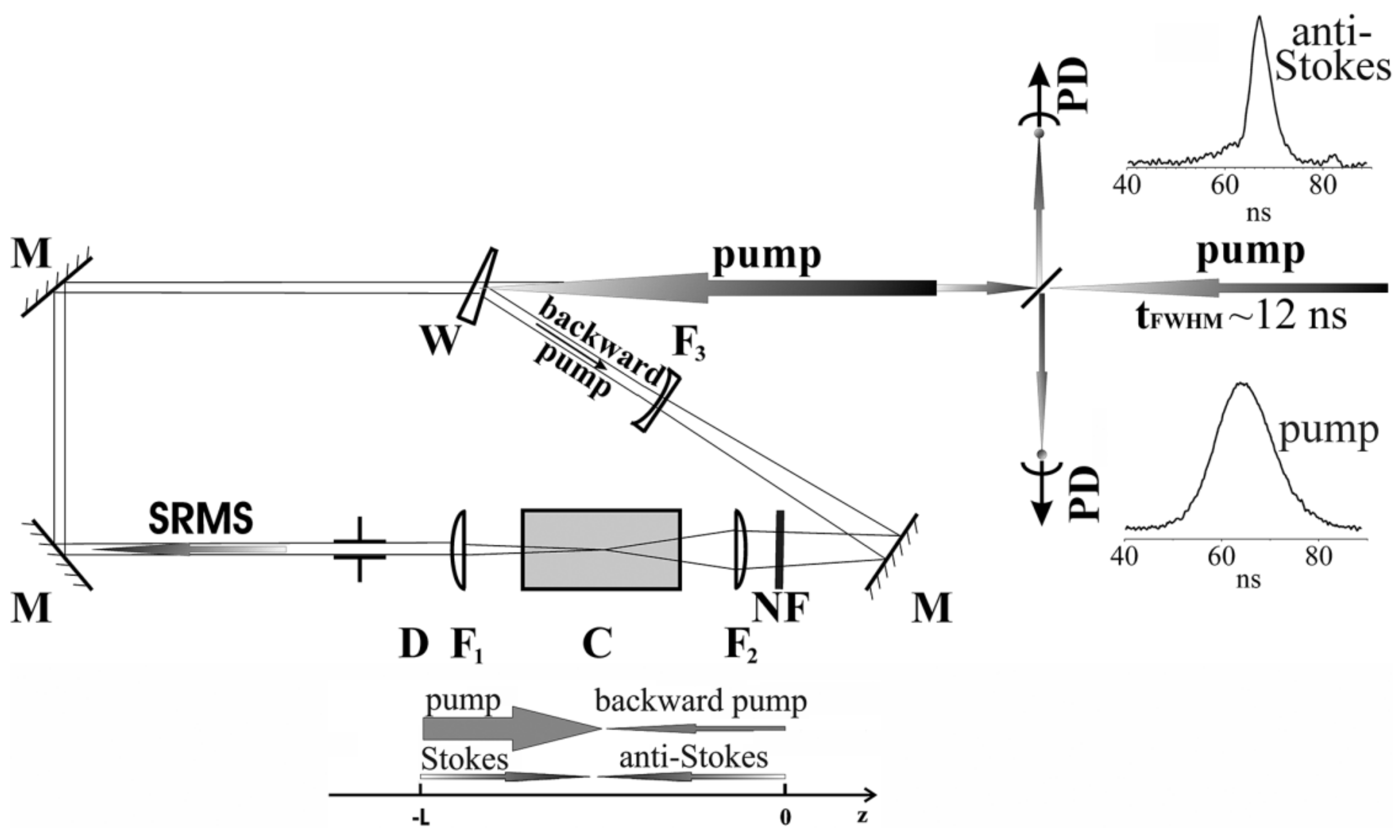
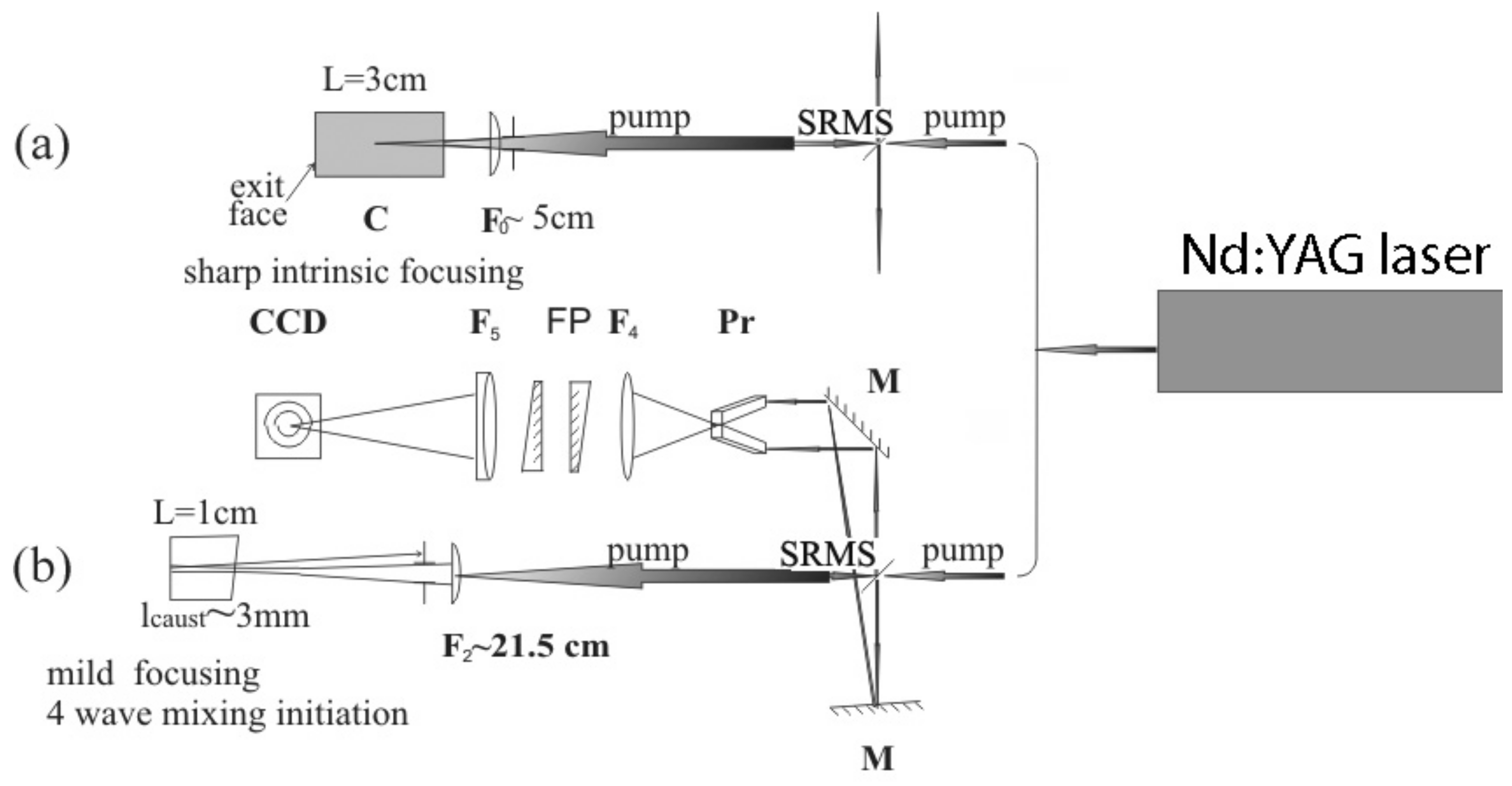
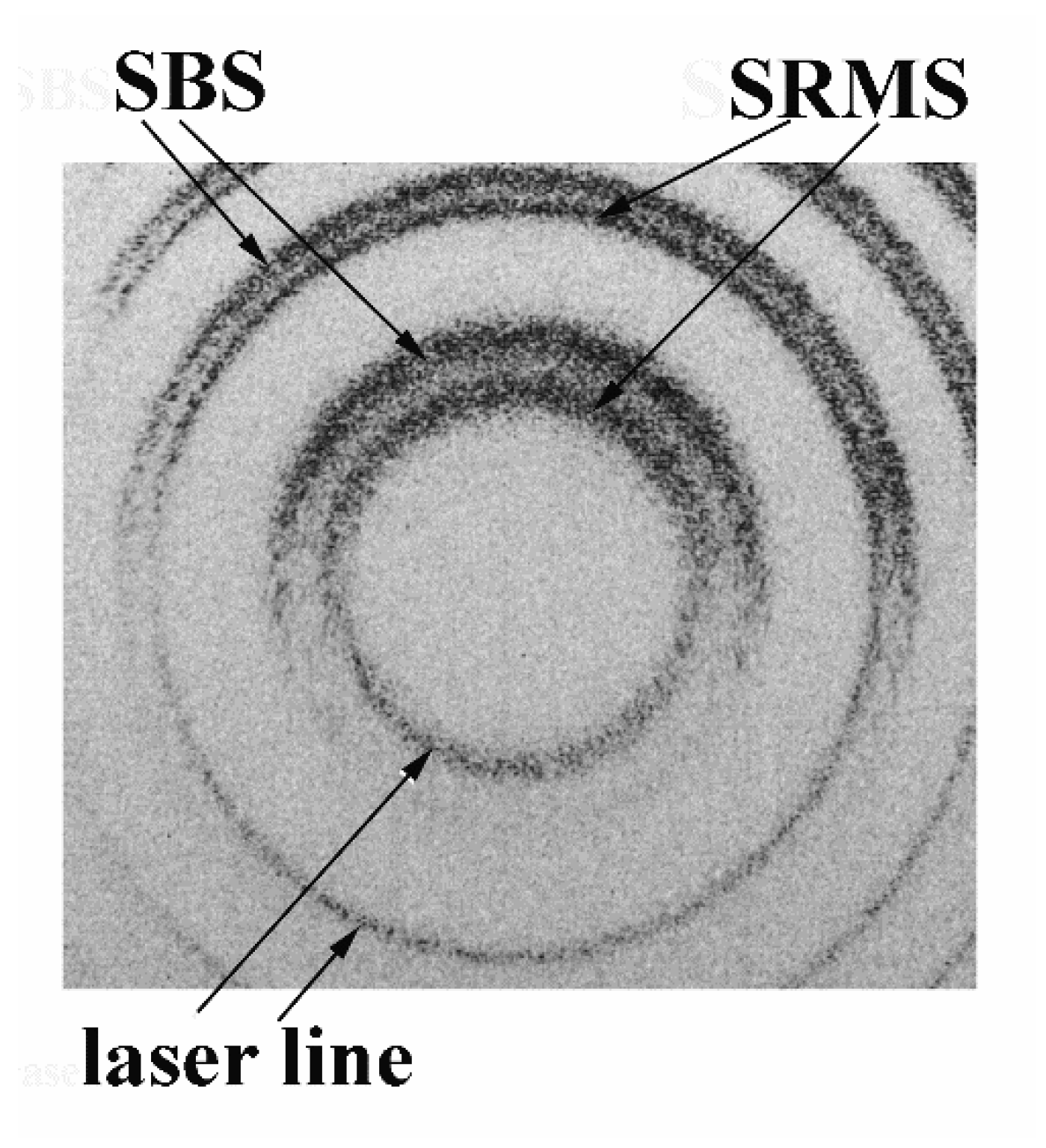

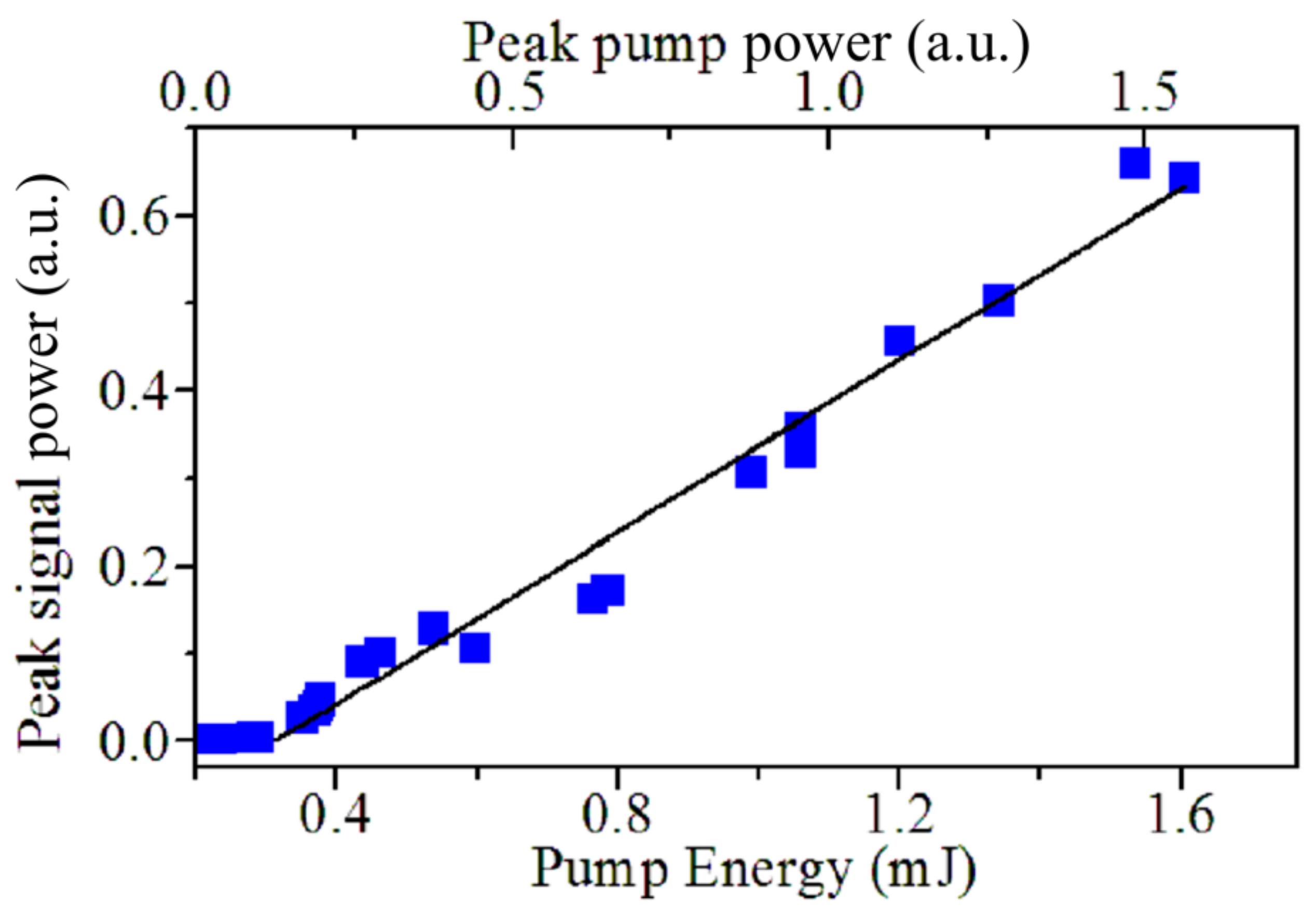
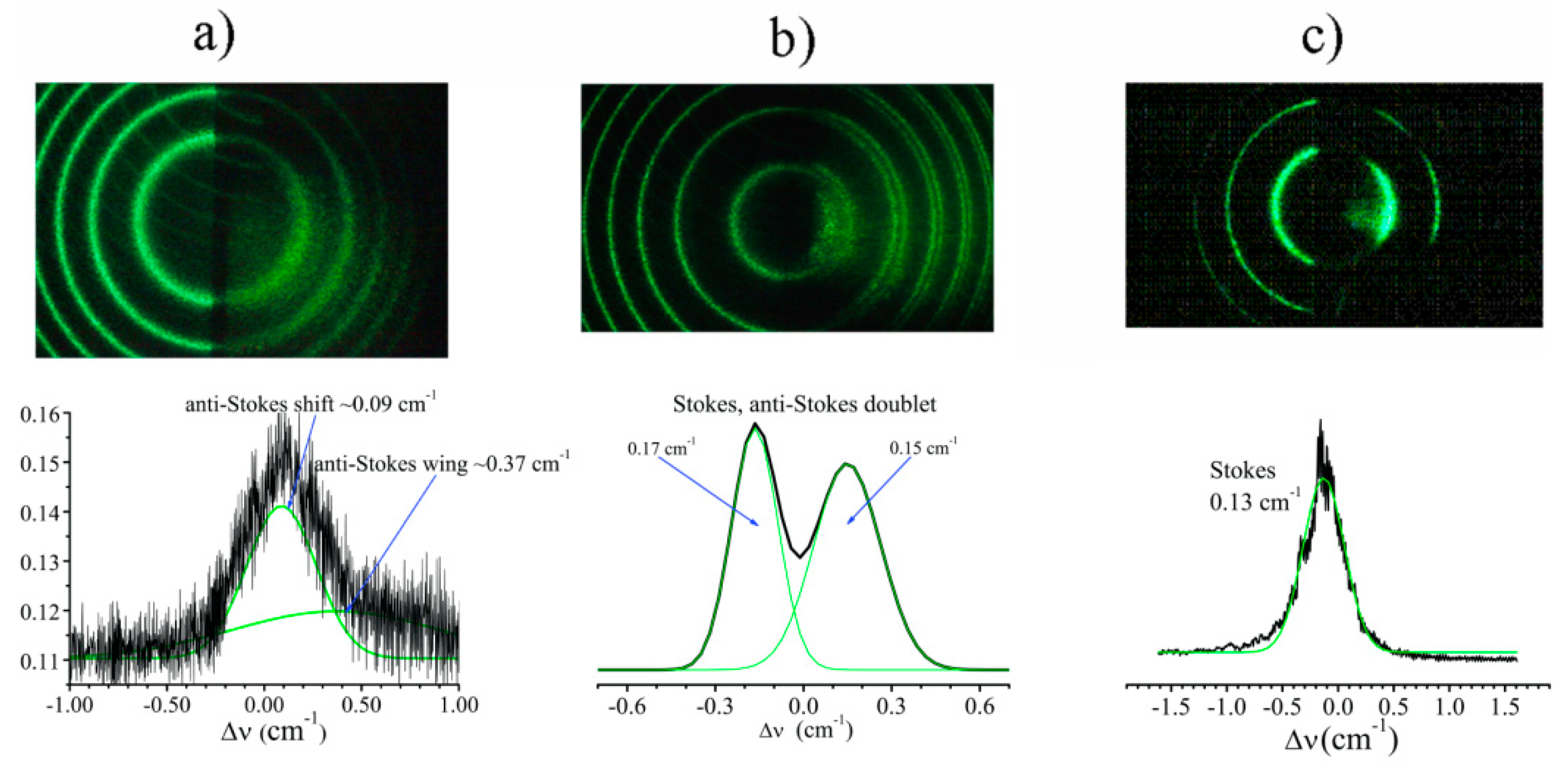
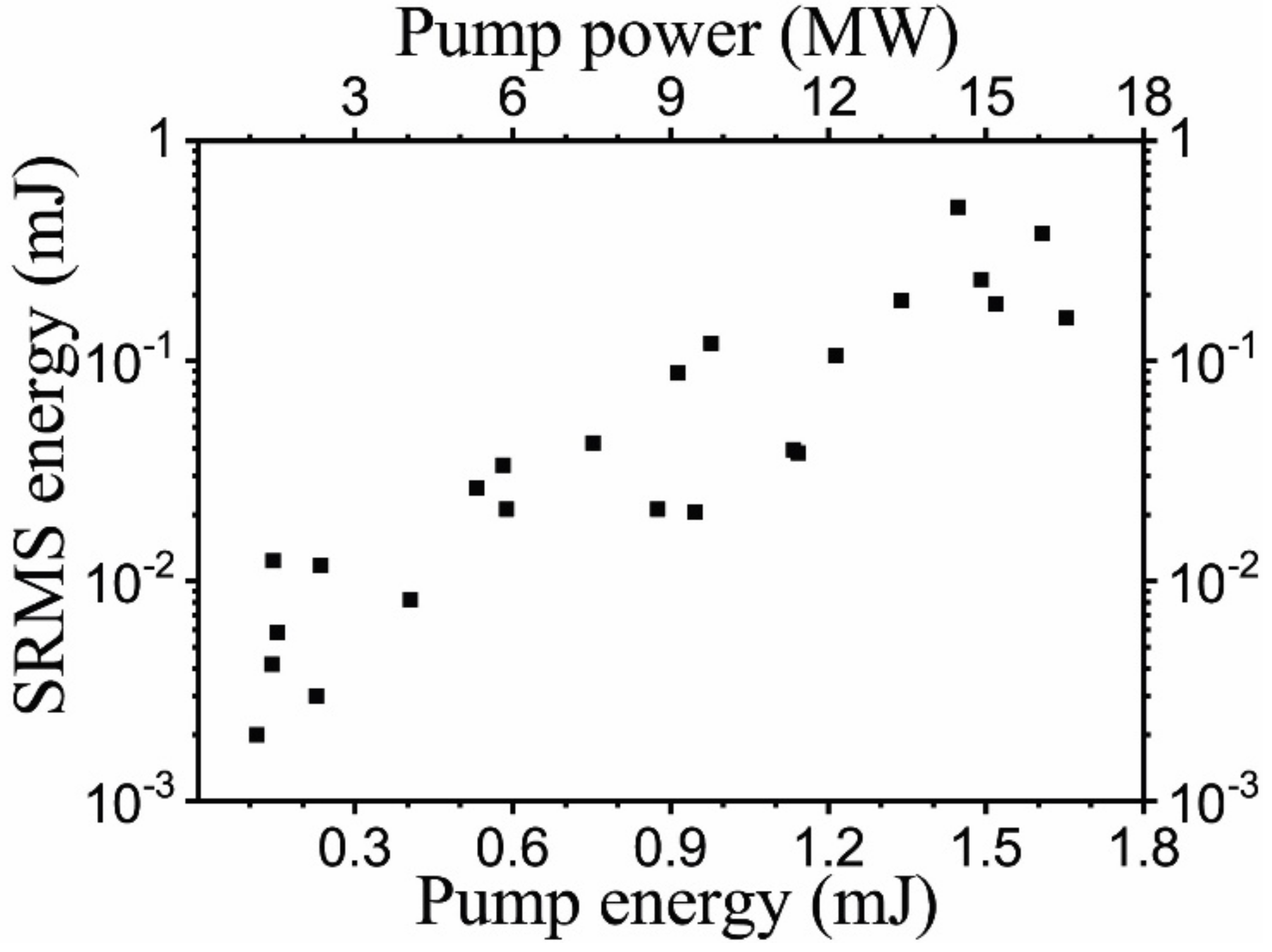
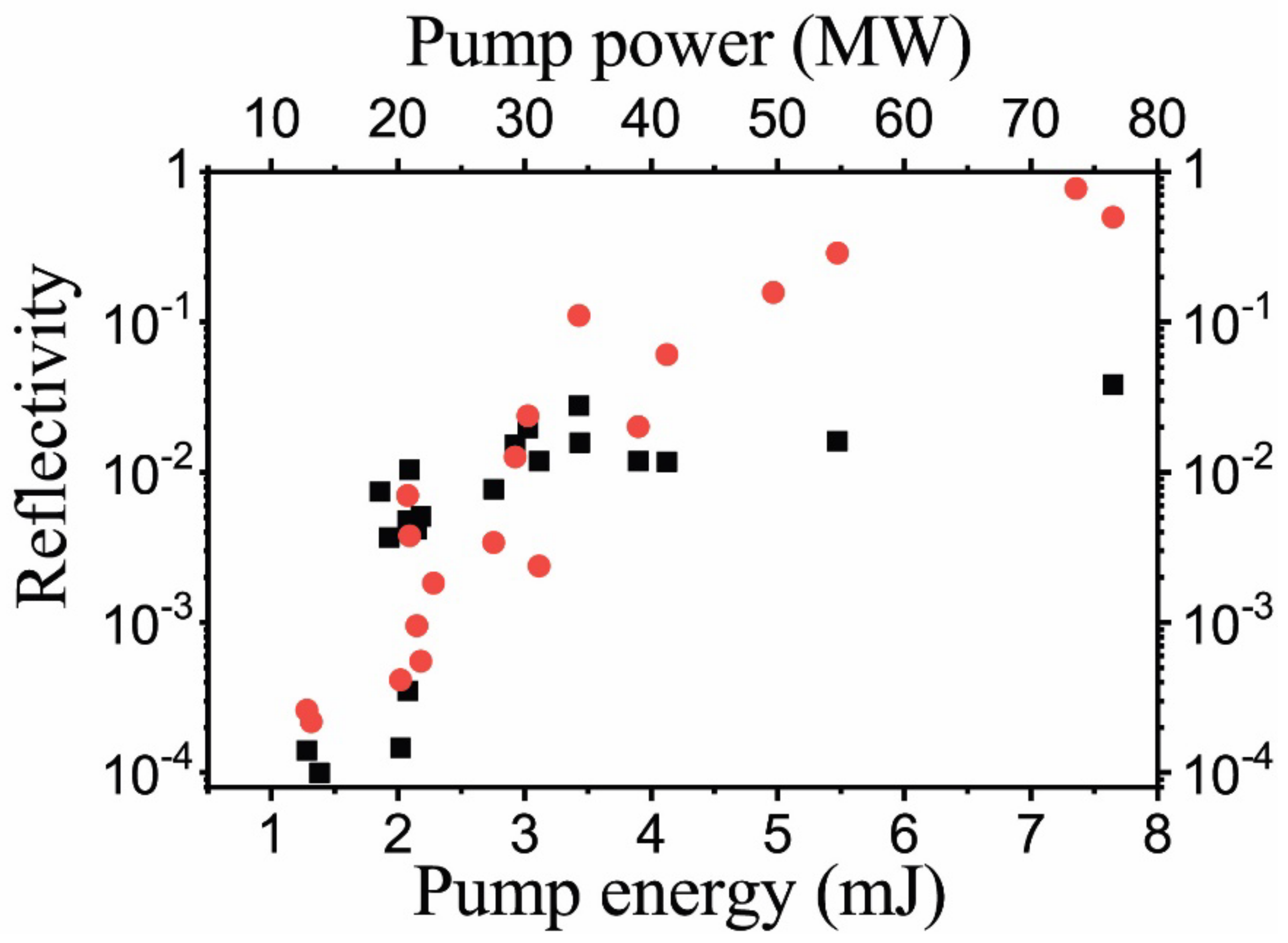
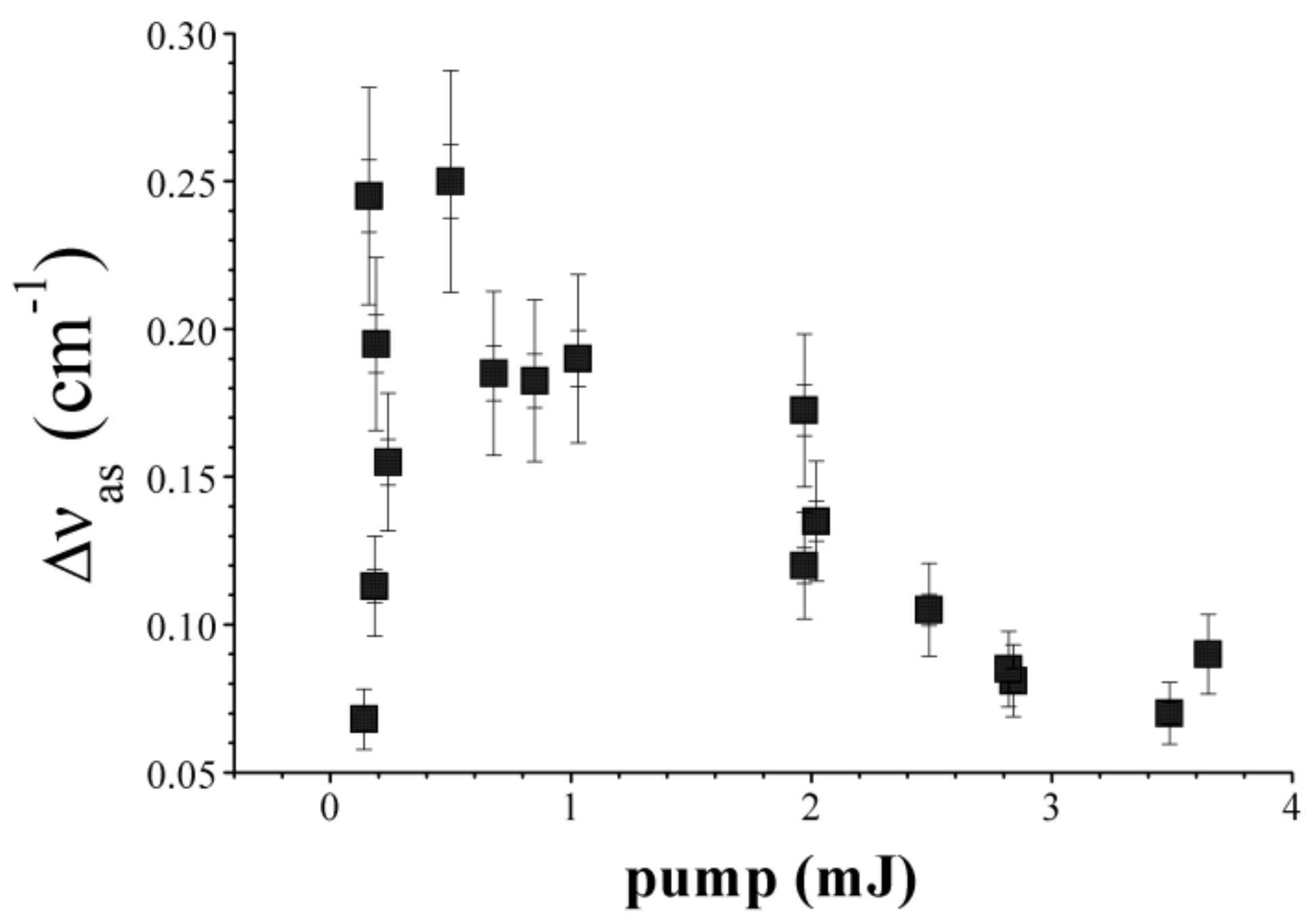
Publisher’s Note: MDPI stays neutral with regard to jurisdictional claims in published maps and institutional affiliations. |
© 2022 by the authors. Licensee MDPI, Basel, Switzerland. This article is an open access article distributed under the terms and conditions of the Creative Commons Attribution (CC BY) license (https://creativecommons.org/licenses/by/4.0/).
Share and Cite
Erokhin, A.I.; Bulychev, N.A.; Parkevich, E.V.; Medvedev, M.A.; Smetanin, I.V. Stimulated Thermal Scattering in Two-Photon Absorbing Nanocolloids under Laser Radiation of Nanosecond-to-Picosecond Pulse Widths. Nanomaterials 2022, 12, 2567. https://doi.org/10.3390/nano12152567
Erokhin AI, Bulychev NA, Parkevich EV, Medvedev MA, Smetanin IV. Stimulated Thermal Scattering in Two-Photon Absorbing Nanocolloids under Laser Radiation of Nanosecond-to-Picosecond Pulse Widths. Nanomaterials. 2022; 12(15):2567. https://doi.org/10.3390/nano12152567
Chicago/Turabian StyleErokhin, Alexander I., Nikolay A. Bulychev, Egor V. Parkevich, Mikhail A. Medvedev, and Igor V. Smetanin. 2022. "Stimulated Thermal Scattering in Two-Photon Absorbing Nanocolloids under Laser Radiation of Nanosecond-to-Picosecond Pulse Widths" Nanomaterials 12, no. 15: 2567. https://doi.org/10.3390/nano12152567






